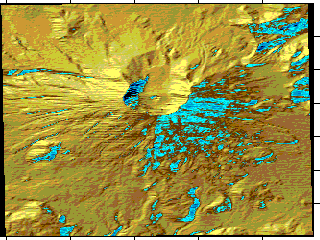Current Research Projects

Small Lakes and Ponds

Boundary-Layer Parameterizations of Drag over Small Scale Topography
Sub-grid scale terrain variations (with horizontal scale from 10m to 100km)
can exert significant drag on the atmospheric boundary-layer flow over
them and can consequently have a siginificant influence on large-scale
atmospheric flows. To incorporate this sub-grid scale effect in regional
and global weather and climate models, a parameterization of small-scale
topographic impacts is needed. This can, in principle, be achieved by adjustments
to drag coefficient or by evaluating an effective roughness length.
We use the mixed spectral finite difference (MSFD, Ayotte et al. 1994),
the non-linear extension of MSFD (NLMSFD, Xu et al 1994) and finite difference
models as tools to investigate the impacts of small-scale topography on
drag and effective roughness. We find in the neutrally stratified situation
that drag varies quadratically with the slope of the underlying surface
(Xu and Taylor 1995). Work associated with stably stratified atmosphere
are underway and progressing.
References
Ayotte, K.W., Xu, D. and Taylor, P.A., 1994, 'The impacts of turbulence
closure on predictions of the mixed spectral finite difference model for
flow over topography', Boundary-Layer Meteorology, 68, 1-33.
Xu, D., Ayotte, K.W. and Taylor, P.A., 1994, 'Development of a non-linear
mixed spectral finite difference model for turbulent boundary-layer flow
over topography', Boundary-Layer Meteorology, 70, 341-367.
Xu, D. and Taylor, P.A., 1995, 'Boundary-Layer parameterization of drag
over samll scale topography', Quarterly Journal of Royal Meteorological
Society, 121, 433-443.


Northern Boundary-Layer Modelling
The project has two principle objectives. The first is to model planetary
boundary-layer structure under a range of conditions appropriate to Northern
Canada and to test these models against field observations. Conditions
considered will include strong winds with blowing snow and springtime snowmelt
situations and would initially involve 1-D (z), time dependent models.
Particular attention will be paid to sublimation under blowing snow situation
and the determination of evaporation/ablation from wet or dry snow covered
surfaces. A second objective is to couple models of boundary-layer flow
over complex terrain with models of blowing snow to parameterize moisture
and other fluxes over heterogeneous terrain with emphases on the snow redistribution
and the effects of heterogeneity on evaporation.


Ground level Ozone Trends in Ontario
Meteorology plays an important role in ozone formation and transportation.
As a result, the substantial variations in meteorological conditions (on
all time scales) can exert such large impacts on ozone concentrations that
they may mask any long term trends in ozone that could reasonably be traced
to changes in precursor emissions such as NOx ans VOC.
We have developed a regression model with variables including a linear
trend, seasonal variations (i.e. an annual cycle), meteorological parameters
(temperature, sunshine hours and relative humidity) and a categorical variavle.
By comparing the trends obtained with and without considering meteorological
impacts, we are able to estimate the meteorological effects. Moreover,
with this regression model we can identify the ground level ozone associated
with changes in precursor emissions (Xu et al. 1996).
Reference
Xu, D, Yap, D. and Taylor, P.A., 1996, 'Meteorologically adjusted ground
level trends in Ontario',
Atmospheric Environment,
30-7, 1117-1124.



